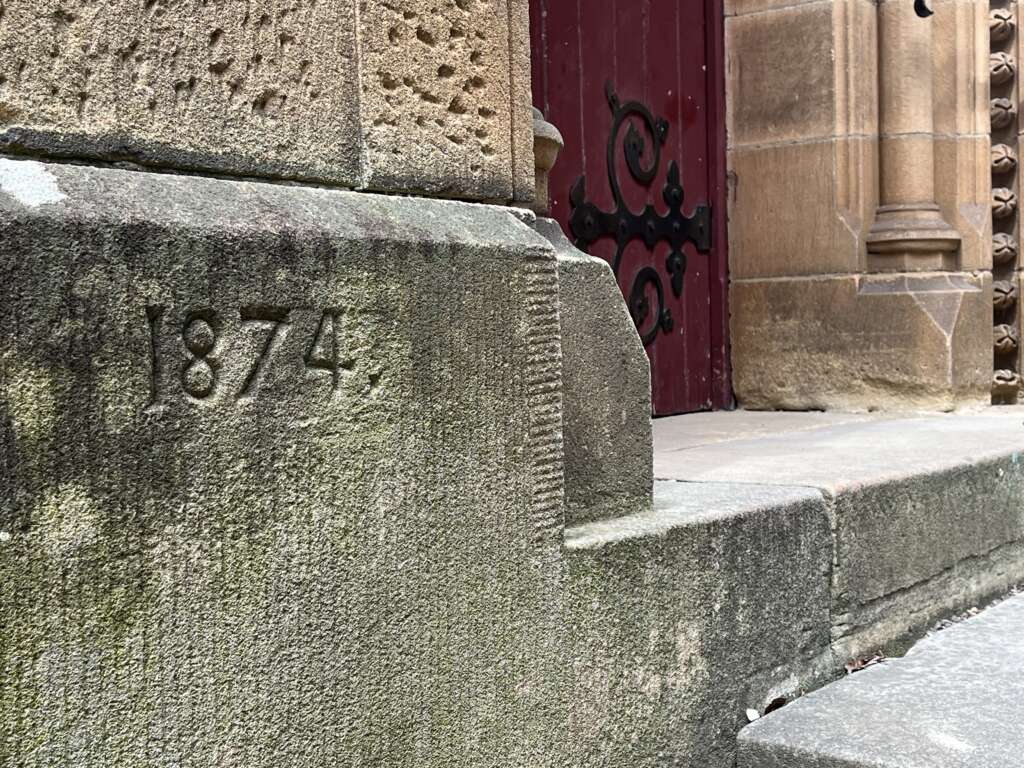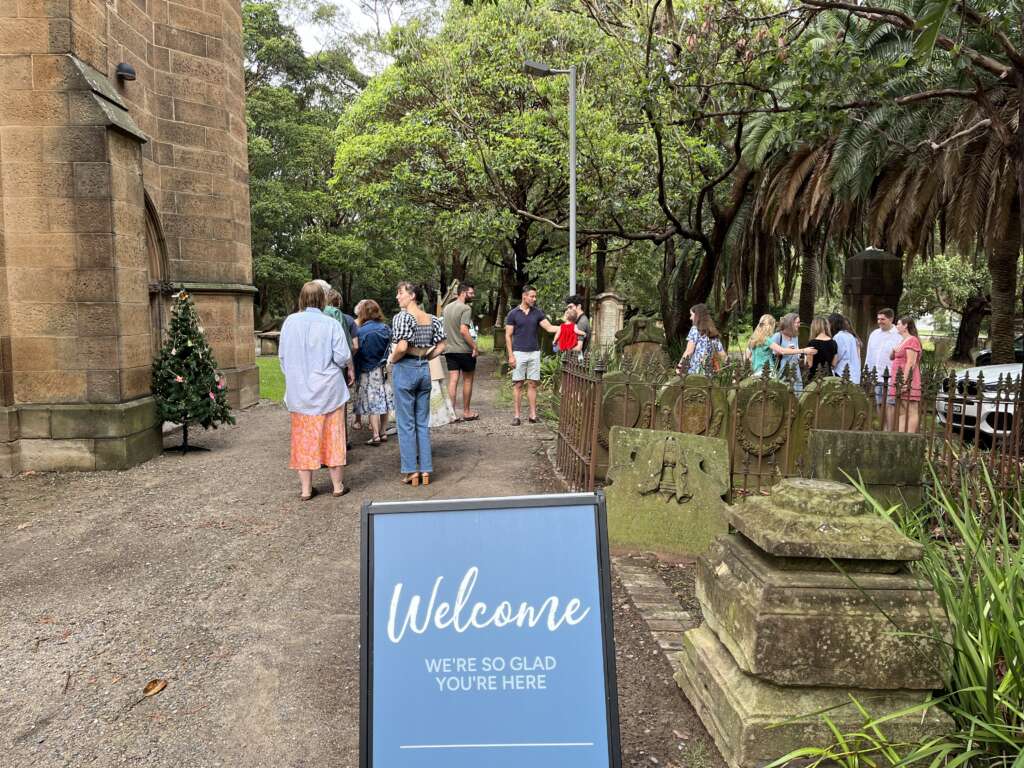St Stephen’s Anglican Church, the graceful building overlooking Newtown and Camperdown in Sydney’s inner west, is turning 150. Built in the midst of Camperdown Cemetery, it has shielded and sustained a Christian community in Sydney’s inner west through the end of the Victorian era, the turmoil of two world wars, and the emergence of contemporary Australia.
Designed by University of Sydney architect Edmund Blacket, St Stephens is considered among his most mature architectural achievements. Though much loved as a spiritual home by many, St Stephen’s was nearly bereft of a congregation more than once in the 20th century. Yet today, it hosts a vibrant church community that feels like a new flowering, according to its senior minister, Andrew Errington.

Andrew Errington
Errington says 150 years is a mere drop in the ocean of time of the site’s history. The native grasses in Camperdown Cemetery are a reminder of when the Gadigal people dwelt and cared for this place.
“Yet it is also enough time for a building to show its age, and there are now a number of pressing and challenging maintenance needs. We are grateful for your interest and willingness to help sustain St Stephen’s in this wonderful new season of life,” Errington told his congregation.

Among the many stories compiled to celebrate the sesquicentenary of St Stephen’s are its contributions to cultural history, which include frequent appearances as a filming location.
“Some people might remember E Street and My Place, both filmed at St Stephen’s. As well as the recent ABC series of Marcus Zusak’s The Messenger, which has several scenes shot at the church,” says Errington.
The many music videos filmed at St Stephen’s include Temper Trap performing Love Lost Live at the Chapel, Guy Sebastian’s filming at St Stephen’s, and Tim Finn’s Made My Day, filmed in St Stephen’s in 1983.
In the beginning
In the beginning was a patch of Gadigal land.
In 1805, 100 hectares of the patch was “given” to the fourth incoming governor of the colony of NSW. His name was William Bligh. Yes, the same William Bligh from the infamous mutiny on the Bounty. In an effort to downplay the mutiny, Bligh proudly named his land grant Camperdown – after his most victorious sea battle, the Battle of Camperdown, fought off the Dutch coast a decade earlier.
At that time, the colony was not a stable place. Governor Bligh and his daughter, Mary, knew the appointment would be tough, and sure enough, Bligh’s worst nightmare unfolded when another mutiny – later known as the “Rum Rebellion” had them under house arrest for over a year.

St Stephen’s Newtown today
Once released, Bligh returned to England, happy to be rid of the “God-forsaken” colony. Daughter Mary, however, had other plans. She married her father’s assistant, Lieutenant Governor Sir Maurice O’Connell, and took up residence in the Bligh Terrace situated on the New Town Road and Bligh Street (now named Carillon Avenue). The locality then became known as O’Connell Town.
Bligh died in England in 1817. Over time, a section of his Camperdown estate was gifted by the Bligh daughters to build a new branch of the Church of England in the colony. In 1844, the foundation stone was laid on the site of “New Town Road”, near Victoria Street. The new church was named “St Stephen’s, Camperdown”. A decade later this area became known as Newtown.
Not long after the original St Stephen’s was built, the congregation realised it was too small. So, with abundant prayer, they set out to build a bigger church.
The first was not the last
The original St Stephen’s Anglican Church, built in 1845, was not the majestic building that now stands in Church Street. But not long after the original St Stephen’s was built on Stephens Street, the congregation realised it was too small. So, with abundant prayer, they set out to build a bigger church. Nearby land within the Church of England cemetery, established in 1848, just 300 metres along Victoria Street, was the obvious location.
The new St Stephen’s building, consecrated in the graveyard in 1874, did not mean an end to the old one. The two would overlap for another 64 years.

Families arrive at St Stephen’s Church, Newtown.
The original St Stephen’s was converted into a Church of England school, which remained until 1907. After 1907, it served the congregation as their parish hall. During the 64-year overlapping period, it was commonplace on a Sunday morning to see hundreds of children walking and skipping from the new St Stephen’s in Church Street down Victoria Street to the original church building for Sunday School.
Sadly, the original church burnt down in 1938 when a gusty gale flung sparks from a neighbour’s burn-off onto the church roof. The children inside, rehearsing for a Sunday school concert, relocated outside and watched the disaster unfold.
The St Stephen’s pews
In the early church, people usually stood for the service, interspersed with lots of kneeling and standing. But in the 1500s, the Reformation meant that church services became more focused on listening to a sermon. People needed seats! Most seats were wooden benches, or “pews”. Wealthy families would rent or buy “box pews” from the church, which let a family sit together in a regular spot. The better the seat, the more you paid. The money went to the church and helped pay for maintenance. Most churches provided some “free” pews at the back for poor people and visitors, but these seats weren’t as comfortable and people couldn’t see what was happening very well.
In 1840, people began to argue about pews, saying everyone should be able to come to church and gather with God’s people without paying for a seat. Robert Taylor, the minister at St Stephen’s Newtown, agreed and promised that half of all the pews would be free and open to anyone. Even better, these pews weren’t at the back or hidden away where it was hard to see – they were right up the front with some of the best views.
(Story by Beccy Sharley)

The St Stephen’s gallery
During the Victorian era, a church’s gallery usually housed a large pipe organ or was exclusively used by the choir, often referred to as the choir loft. At that time, music was considered most desirable when heard from behind the seated audience. This was the closest the Victorian era could get to achieving surround sound.
However, St Stephen’s Newtown forfeited this pleasure – neither the organ nor the choir occupied the gallery. Instead, the gallery was assigned to the children. Low benching was specially crafted to accommodate them and to pack in as many children as possible. This simple seating remains in the gallery today. The doors at the bottom of the gallery steps allowed the children to enter and exit the building easily, without disrupting the adults in the church.
It would be interesting to know if St Stephen’s sacrificed the sound of lofty hymns wafting from behind for the lively chatter of children or if the Victorian thinking that “children should be seen and not heard” prevailed.
The fact that the church sits among the graves in Camperdown Cemetery is partly owed to an Act of Parliament in 1871 …
The church in the cemetery
The imposing gates and Cemetery Lodge, nestled under the darkening branches of the fig, are the first point of entrance to St Stephen’s, Newtown. Walking up the original carriageway, it is difficult not to notice the proximity of the gravestones to the building. In the way the roots of the fig tree disturb the earth, these sandstone graves emanate from the church.
The fact that the church sits among the graves in Camperdown Cemetery is partly owed to an Act of Parliament in 1871 which granted the church permission to build within the cemetery grounds. In the years leading up to this Act of Parliament, government inquiries had taken place into the state of Sydney’s cemeteries. Poor drainage, complaints of effluviant odours, the practice of the “packing system”, and overcrowding contributed to the decision to close the cemetery.
As the cemetery had been established in 1848 as a company and then dissolved in 1868 by Acts of Parliament, the parish of St Stephen’s required parliamentary permission to build a church there. As the 1871 Act states, “And whereas divers portions of the said land have not been used for the purposes of burial and some of such portions have not been consecrated … said unused portions of the said land are suitable for the erection thereon of a Church and of a residence for the Minister.” Thus, the church within the cemetery was born. These graves, crowding around the building, are revenants of the site’s complex history.
You can celebrate St Stephen’s Sesquicentenary at the following events:
- 10am, Sunday 7 April – Celebration Service, followed by a community lunch.
- 7pm, Monday 8 April – Anglican Deaconess Ministries will host an event to recognise the significant role St Stephen’s has played in the history of women’s ministry in Sydney.
- 7pm, Tuesday 9 April – the date on which St Stephen’s was opened in 1874 – a history presentation will be given, followed by a service in a traditional style to commemorate the foundational ministry of the church.
Marcelle Rodgers is a pastoral minister at Newtown and Erskineville Anglican Church, based at St Stephen’s.
Email This Story
Why not send this to a friend?



